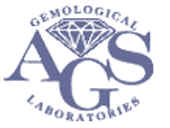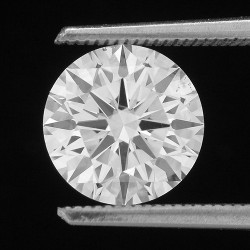 The new AGS cut grade system is comprised of eleven components:
The new AGS cut grade system is comprised of eleven components:
Light Performance
 1) Contrast – When a diamond is viewed, the viewer’s head and body, surrounding environment and different lighting can produce contrast that is the relative difference of brightness. The eye tends to perceive contrasting facets more attractive than if they are all the same.
1) Contrast – When a diamond is viewed, the viewer’s head and body, surrounding environment and different lighting can produce contrast that is the relative difference of brightness. The eye tends to perceive contrasting facets more attractive than if they are all the same.
2) Brightness – The ability of a diamond to reflect back the light it gathers from above. Brilliance is defined as brightness with positive contrast.
3) Dispersion – The perception of fire is caused by dispersion and is enhanced with multiple light sources (i.e., spot lights in ceiling of jewelry store or convention center) and diminished with broad diffused light (i.e., fluorescent light fixture).
4) Leakage – When light leaks out the sides or bottom of a diamond, it reduces the light reflected out the top.
Proportion Factors
5) Tilt – When a diamond is viewed at enough of an angle, the reflection of the girdle becomes visible at the edge of the table. A minimum pavilion angle is determined for each table percentage to ensure an acceptable tilt angle is achieved.
6) Durability – The cut grade is reduced for girdles rated extremely thin and very thin. Diamonds with crown angles less than 30 degrees are also more susceptible to damage.
7) Weight Ratio – The relative size of a diamond compared to its weight is known as “spread. Most diamond shoppers want the largest millimeter size that weighs the least while still having exceptional light performance.
8) Girdle Thickness – Traditionally the thickness of the girdle were measured at the thinnest point or “valley” by grading laboratories in the United States. The new AGS cut grade system now measures girdle thickness at the thick part or “peak.”
AGS CUT AND GIRDLE GRADES
| AGS GRADE | Description | Girdle Thickness |
| 3 | Extremely Thin | 0 at any spot |
| 1 | Very Thin | 1.8-2.19% |
| 0 | Thin | 2.2-2.99% |
| 0 | Medium | 3.0-3.99% |
| 0 | Slightly Thick | 4.0-4.99% |
| 3 | Thick | 5.0-5.99% |
| 5 | Very Thick | 6.0-6.99% |
| 7 | Extremely Thick | 7.0-7.99% |
| 8 | Extremely Thick | 8.0-8.99% |
| 9 | Extremely Thick | 9.0-9.99% |
| 10 | Extremely Thick | >10% |
Finish
10) Polish – The polish grade refers to the amount and visibility of the polish features present on the diamond surface. The AGS uses a numerical scale to grade the visibility of polish.
- AGS-0 Ideal: Extremely difficult to locate under 10X magnification
- AGS-1 Excellent: Very difficult to locate under 10X magnification
- AGS-2 Very Good: Difficult to locate under 10X magnification
- AGS-3 Good: Relatively easy to see under 10X, not visible to the unaided eye
- AGS-4 Good: Easy to see under 10X, extremely difficult to see with unaided eye
- AGS-5 Fair: Very easy to see under 10X, very difficult to see with unaided eye
- AGS-6 Fair: Obvious under 10X, difficult to see with the unaided eye
- AGS-7 Fair: Relatively easy to see without magnification
- AGS-8 Poor: Easy to see without magnification
- AGS-9 & AGS-10 Poor: Obvious to the unaided eye
11) Symmetry – The symmetry grade refers to the amount and visibility of the symmetry features present on the diamond surface. The AGS uses a numerical scale to grade the visibility of polish.
- AGS-0 Ideal: Extremely difficult to locate under 10X magnification
- AGS-1 Excellent: Very difficult to locate under 10X magnification
- AGS-2 Very Good: Difficult to locate under 10X magnification
- AGS-3 Good: Relatively easy to see under 10X, not visible to the unaided eye
- AGS-4 Good: Easy to see under 10X, extremely difficult to see with unaided eye
- AGS-5 Fair: Very easy to see under 10X, very difficult to see with unaided eye
- AGS-6 Fair: Obvious under 10X, difficult to see with the unaided eye
- AGS-7 Fair: Relatively easy to see without magnification
- AGS-8 Poor: Easy to see without magnification
- AGS-9 & AGS-10 Poor: Obvious to the unaided eye
Princess Cut Grade
In early 2005, the AGS implemented a cut grade for princess cut diamond shapes. This was the first time a diamond grading report included a cut grade for a fancy shape. As AGS research continues, they intend to roll out cut grades for other fancy shapes.
Because there was historically no cut grade for princess-cut shapes, diamond cutters traditionally focused on maximum weight retention that increased their profits. As a result, few princess-cuts on the market today meet the AGS 0-cut standards. It is estimated that only the top 20% would get an AGS cut grade of 2 or better and only about 3% would be awarded the 0-cut grade. The princess 0-cuts tend to have higher crown-heights and smaller tables. However, since the new AGS cut grading depends on a 3-dimentional scan of the diamond and the use of proprietary AGS software, the only way to determine the AGS princess cut grade is to have the AGS grading report.
There is considerably more diamond waste required in the cutting process to achieve a 0-cut. As a result, the price will be greater. Currently only a very small percentage of the princess-cuts are sent to the AGS and these tend to be the diamonds with exceptional cut. Because the typical princess diamond shopper is unaware of the AGS cut grades for princess-cuts, there is little incentive for cutters to incur the additional cost associated with the 0-cut. Jewelry stores will continue to buy the cheapest inventory possible (average to poor cut) and will be slow to educate their customers about cut grades for princess-cuts.
Emerald Cut Grade
In the third quarter of 2006, the AGS Laboratories began issuing Diamond Quality Documents that include cut grades for emerald-cut diamonds, including square emeralds (Asscher cuts), rectangular emeralds and octagon step cuts.
The AGS Performance-based Cut Grading System measures all facets of the diamond in three dimensions to grade stones on “performance” rather than proportion. The lab considers the same light performance and proportion factors that are used for round brilliants and princess cut diamonds.
There is a very limited number of emerald cut diamonds on the wholesale market at this time with the AGS certification including the new cut grade. The AGS cut graded emerald cut diamonds we have seen thus far tend to have depth percentages in the 65% to 71% range and table percentages in the 58% to 66% range. We will be updating this section as we learn more about the new AGS emerald cut grade.
